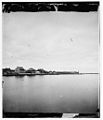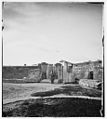St. Augustine, Florida
City of St. Augustine | |
|---|---|
 | |
| Nickname(s): Ancient City, Old City | |
 Location in St. Johns County and the state of Florida | |
| Country | |
| State | |
| County | |
| Established | 1565 |
| Government | |
| • Mayor | Joseph L. Boles |
| Area | |
| • City | 10.7 sq mi (27.8 km2) |
| • Land | 8.4 sq mi (21.7 km2) |
| • Water | 2.3 sq mi (6.1 km2) |
| Elevation | 4.99 ft (1.52 m) |
| Population (2010) | |
| • City | 12,975 |
| • Density | 1,385/sq mi (534.7/km2) |
| • Metro | 1,277,997 |
| Time zone | UTC-5 (EST) |
| • Summer (DST) | UTC-4 (EDT) |
| Area code | 904 |
| Website | http://www.staugustinegovernment.com/ |
St. Augustine is a city in the northeast section of Florida and the county seat of St. Johns County, Florida, United States.Template:GR Founded in 1565 by Spanish explorer and admiral Pedro Menéndez de Avilés, it is the oldest continuously occupied European-established city and port in the continental United States.[1] St. Augustine lies in a region of Florida known as "The First Coast", which extends from Amelia Island in the north to Jacksonville, St. Augustine, and Palm Coast in the south. According to the 2010 census, the city population was 12,975.Template:GR St. Augustine is the headquarters for the Florida National Guard.
History
Early exploration and attempts at settlement
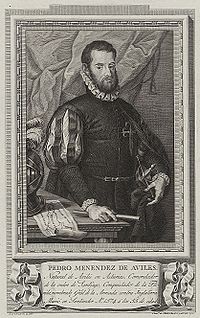
The vicinity of St. Augustine was first explored in 1513 by Spanish explorer and governor of Puerto Rico, Juan Ponce de León, who claimed the region for the Spanish crown.[2] Prior to the founding of St. Augustine in 1565, several earlier attempts at European colonization in what is now Florida were made by both Spain and France, but all failed.
The French exploration of the area began in 1562, under the Huguenot captain Jean Ribault. Ribault explored the St. Johns River to the north of St. Augustine before sailing north, ultimately founding the short-lived Charlesfort on what is now known as Parris Island, South Carolina. In 1564, Ribault's former lieutenant René Goulaine de Laudonnière headed a new colonization effort. The Laudonnière explored St. Augustine Inlet and the Matanzas River, which the French named the River of Dolphins.[3] There they made contact with the local Timucua chief, probably Seloy, a subject of the powerful Saturiwa chiefdom, before heading north to the St. Johns River. There they established Fort Caroline.
Later that year some mutineers from Fort Caroline fled the colony and turned pirate, attacking Spanish vessels in the Caribbean. The Spanish used this as a catalyst to locate and destroy Fort Caroline, fearing it would serve as a base for future piracy, and wanting to dissuade further French colonization. The Spanish quickly dispatched Pedro Menéndez de Avilés to go to Florida and establish a base from which to attack the French.[1]
Founding of St. Augustine

Pedro Menéndez de Avilés sighted land on August 28, 1565. As this was the feast day of Augustine of Hippo, the territory was named San Agustín. The Spanish sailed through the St. Augustine Inlet into Matanzas Bay and disembarked near the Timucua town of Seloy on September 7.[4][5][6][7][8] Menéndez's goal was to dig a quick fortification to protect his people and supplies as they were unloaded from the ships, and then to take a more proper survey of the area to determine the best location for the fort. The location of this early fort has been confirmed through archaeological excavations directed by Kathleen Deagan on the grounds of what is now the Fountain of Youth Archaeological Park.[9] It is known that the Spanish occupied several structures in Seloy, the chief of which, known as Chief Seloy, was allied with the Saturiwa, Laudonnière's allies. It is possible, but undemonstrated, that Menéndez fortified one of the occupied Timucua structures as this first fort at Seloy.[4] In the meantime, Jean Ribault, Laudonnière's old commander, arrived at Fort Caroline with more settlers for the colony, as well as soldiers and weapons to defend them. He also took over the governorship of the settlement. Despite Laudonnière's wishes, Ribault put most of these soldiers aboard his ships for an assault on St. Augustine. However, he was surprised at sea by a violent storm lasting several days. This gave Menéndez the opportunity to march his forces overland for surprise dawn attack on the Fort Caroline garrison, which then numbered several hundred people. Laudonnière and some survivors fled to the woods, and the Spanish killed almost everyone in the fort except for the women and children. With the French displaced, Menéndez rechristened the fort as San Mateo, and appropriated it for his own purposes. The Spanish then returned south and eventually encountered the survivors of Ribault's fleet near the inlet at the southern end of Anastasia Island. Menéndez executed most of the survivors, including Ribault; the inlet was thus named for the Spanish word for slaughters, matanzas.
The first slaves in the territory that we now regard as the United States were brought to St. Augustine on the day it was founded by Pedro Menéndez de Avilés on September 8, 1565. Menéndez’s contract with King Phillip afforded him three years to import 500 African slaves.[10][unreliable source?] In 1566, Martín de Argüelles was born in San Agustín, the first European child who was recorded as born in the continental United States. Argüelles was born in San Agustín 21 years before the English settlement at Roanoke Island in Virginia Colony, and 42 years before the successful settlements of Santa Fe, New Mexico, and Jamestown, Virginia. Additionally, the first recorded birth of a black child in the continental United States is in the Cathedral Parish Archives. Augustin was recorded as born in the year 1606, thirteen years before enslaved Africans were first brought to the English colony at Jamestown in 1619.[citation needed] In territory under the jurisdiction of the United States, only Puerto Rico has continuously occupied European-established settlements older than St. Augustine.
Spanish rule
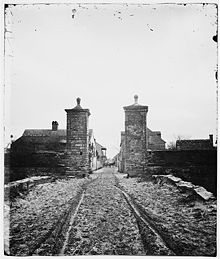

St. Augustine was intended to be a base for further colonial ventures across what is now the Southeastern United States, but such efforts were hampered by apathy and hostility on the part of the Native Americans towards becoming Spanish subjects. The Saturiwa, one of the two principal chiefdoms in the area, remained openly hostile. In 1566 the Saturiwa burned down St. Augustine and the settlement had to be relocated. Traditionally it was thought to have been moved to its present location, though some documentary evidence suggests it was first moved to a location on Anastasia Island. At any rate, it was certainly in its present location by the end of the 16th century.[11]
The settlement also faced attacks from European forces as well. In April 1568 the French soldier Dominique de Gourgues led an attack on Spanish holdings. With the aid of the Saturiwa, Tacatacuru, and other Timucua peoples who had been friendly with Laudonnière, de Gourgues attacked and burned Fort San Mateo, the former Fort Caroline. He then executed his prisoners in revenge for the 1565 massacre, but he did not approach St. Augustine itself. Additional French expeditions were primarily raids and were unable to dislodge the Spanish from St. Augustine. The English also believed Admiral Avilés and the Catholic Spanish were responsible for the disappearance of the English fishing settlements in America which had been established by John Cabot. Thus, following the disappearance of the Roanoke colony in Virginia, the blame was immediately leveled at St. Augustine. Consequently, in 1586 St. Augustine was attacked and burned by English privateer Sir Francis Drake and the surviving Spanish settlers were driven into the wilderness. However, lacking sufficient forces or authority for permanently establishing a settlement, Drake left the area.
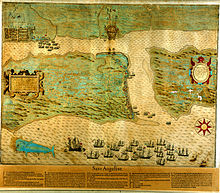
In 1668 St. Augustine was attacked and plundered by English privateer Robert Searle. In the aftermath of his raid, the Spanish began in 1672 the construction of a more secure fortification, the Castillo de San Marcos, which still stands today as the nation's oldest fort. Its construction took a quarter of a century, with many later additions and modifications.
The Spanish did not have as many slaves in Florida as the English Americans had in their colonies to the north, as it was basically a military outpost rather than a plantation economy. As the British settlements moved farther and farther south, the Spanish adopted the policy of giving sanctuary to slaves who could escape from British plantations and make their way to Florida. Thus did it become the focal point of the first Underground Railroad. Blacks were given sanctuary, arms, and supplies if they joined the Catholic Church and swore allegiance to the king of Spain. As the British established settlements closer to Spanish territory, with Charleston in 1670 and Savannah in 1733, Spanish Governor Manual de Montiano in 1738 established the first legally recognized free community of ex-slaves as the northern defense of St. Augustine, known as Gracia Real de Santa Teresa de Mose, or Fort Mose.
In 1740 St. Augustine was unsuccessfully attacked by British forces from their colonies in the Carolinas and Georgia. The largest and most successful of these was organized by Governor and General James Oglethorpe of Georgia who managed to break the Spanish-Seminole alliance when he gained the help of Ahaya the Cowkeeper, chief of the Alachua band of the Seminole tribe.
In the subsequent campaign Oglethorpe, supported by several thousand colonial militia and British regulars along with Seminole warriors, invaded Spanish Florida and conducted the Siege of St. Augustine during the War of Jenkin's Ear. During this siege the black community of St. Augustin proved its worth when during the siege it proved decisive in stopping the city's take-over by the British. The leader of Fort Mose during the battle was the legendary Capt. Francisco Menendez (creole), who was born in Africa, twice escaped from slavery, and played an important role in defending St. Augustine from raid by British colonists to the north. The Fort Mose site is now owned by the Florida Park Service, and recognized as a National Historic Landmark.
British rule
In 1763, the Treaty of Paris ended the French and Indian War and gave Florida and St. Augustine to the British, in exchange for the British relinquishing control of occupied Havana. With the change of flags, almost all of the population of 3,100 Spaniards departed from St. Augustine.
James Grant was appointed the first governor of East Florida, and served from 1764 until 1771, when he returned to Britain due to illness. He was replaced as governor by Patrick Tonyn.
During this time the British converted the monks quarters of the former Franciscan monastery into military barracks which were named St. Francis Barracks. They also built The King's Bakery which is believed to be the only extant structure in the city built entirely in British period.
The Lieutenant Governor of East Florida under Governor Grant was John Moultrie who was born in South Carolina, he had served under Grant as a major in the Cherokee War and remained loyal to the British Crown. Moultrie's brother William Moultrie of whom Fort Moultrie in South Carolina is named was a general in the Continental Army. His brother Thomas was a captain in the American 2nd South Carolina Regiment who was killed in the Battle of Charleston, while his half-brother Alexander became the first Attorney General in South Carolina and was held prisoner in St. Augustine while John was acting British Lieutenant Governor. Moultrie was granted large tracts of land in the St. Augustine vicinity upon which he established the plantation of "Bella Vista" he owned another 2,000-acre (8.1 km2) plantation in the Tomoka River basin named "Rosetta". While acting as the lieutenant governor he lived in the Peck House on St. George Street.
Another large development effort during the British period was the establishment in 1768 of the colony of New Smyrna, by Andrew Turnbull a friend of Grants. Turnbull recruited indentured servants from the Mediterranean, primarily from the island of Minorca. The conditions at New Smyrna were abysmal, prompting the settlers to rebel en masse in 1777 and walk the 70 miles (110 km) to St. Augustine, where Grant gave them refuge.
The story of the Minorcan colony (as the entire group came to be known) is told, fictionally, in the book Spanish Bayonet by Stephen Vincent Benet, a prominent descendant of one of the leading Minorcan families of St. Augustine. The Minorcans stayed on in St. Augustine through all the subsequent changes of flags, to become the venerable families of the community, marking it with language, culture, cuisine and customs.

Second Spanish rule
The Treaty of Paris in 1783, gave the American colonies north of Florida their independence, and ceded Florida to Spain in recognition of Spanish efforts on behalf of the American colonies during the war.
On September 3, 1783, by Treaty of Paris, Britain also signed separate agreements with France and Spain, and (provisionally) with the Netherlands. In the treaty with Spain, the colonies of West Florida, captured by the Spanish, and East Florida were returned to Spain, as was the island of Minorca, while the Bahama Islands, Grenada and Montserrat, captured by the French and Spanish, were returned to Britain.
Florida was under Spanish control again from 1781 to 1821, but St. Augustine since 1784. During this time, Spain was being invaded by Napoleon between 1808 and 1814 and was struggling to retain its colonies. Florida no longer held its past importance to Spain, thus, in 1821 the Adams–Onís Treaty peaceably turned the Spanish colonies in Florida and, with them, St. Augustine, over to the United States as a way of compensating the American government for the civil claims that were in part caused by undefined border areas with Spanish territories.
American Rule
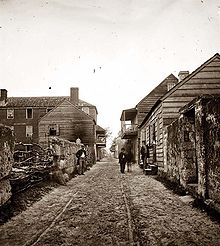
Florida was ceded to the United States by Spain in the 1819 Adams–Onís Treaty, ratification of the treaty took place in 1821 and it officially became a U.S. possession as the Florida Territory, in 1822, with future president Andrew Jackson as the military governor, succeeded by William Pope DuVal as territorial governor. Florida gained statehood in 1845.
After the U.S. took possession of Florida in 1821, the Castillo de San Marcos (British, Fort St. Marks) was renamed Fort Marion for Francis Marion, the "Swamp Fox" of the American Revolution.
During the Second Seminole War of 1835–1842 the fort served as a prison for Seminole captives including the famed leader Osceola, the black Seminole, John Cavallo (John Horse) as well as Coacoochee (Wildcat), who made a daring escape from the fort with 19 other Seminoles.

In 1861, the American Civil War began and Florida seceded from the Union and joined the Confederacy. On January 7, 1861, prior to Florida's formal secession, a local militia unit, the St. Augustine Blues, took possession of St. Augustine's military facilities, including Fort Marion and the St. Francis Barracks, from the lone Union ordnance sergeant on duty.
Crew from the USS Wabash reoccupied the city for the United States government without opposition on March 11, 1862, and it remained under union control for the remainder of the war. In 1865, Florida rejoined the United States.
After the war, former slaves in St. Augustine established the community of Lincolnville in 1866, named after President Abraham Lincoln. Lincolnville, with the largest concentration of Victorian Era homes in St. Augustine, also became a key setting for the Civil Rights Movement a century latter.

After the Civil War, Fort Marion was used twice, in the 1870s and then again in the 1880s, to house first Plains Indians and then Apaches who were captured in the west. The daughter of Geronimo was born at Fort Marion, and was named Marion, though she later chose to change her name. The fort was also used as a military prison during the Spanish-American War of 1898. It was finally removed from the Army's active duty rolls in 1900 after 205 years of service under five different flags. It is now run by the National Park Service, and called the Castillo de San Marcos National Monument.
Flagler era
Henry Flagler, a partner with John D. Rockefeller in Standard Oil arrived in St. Augustine in the 1880s and was the driving force behind turning the city into a winter resort for the wealthy northern elite.[12] Flagler bought a number of local railroads which were incorporated into the Florida East Coast Railway, which built its headquarters in St. Augustine.[13]
Flagler contracted the New York architectural firm of Carrère and Hastings to design a number of extravagant buildings in St. Augustine, among them the Ponce de Leon Hotel and the Alcazar Hotel built partly on land purchased from Flaglers' friend and associate Andrew Anderson and partly on the bed of Maria Sanchez Creek, which Flagler had filled with the archaeological remains of the original Fort Mose. Flagler built or contributed to several churches, including Grace Methodict, Ancient City Baptist, and, most ornate, the Venetian-style Memorial Presbyterian Church.
Flagler had Albert Spalding design a baseball park in St. Augustine, and the waiters at his hotels, under the leadership of Frank P. Thompson, formed one of America's pioneer professional black baseball teams, the Ponce de Leon Giants. It later became the Cuban Giants, and one of the team members, Frank Grant, has been inducted into the Baseball Hall of Fame.
In the 1880s, there was no public hospital between Daytona Beach and Jacksonville. On May 22, 1888, Flagler invited St. Augustine's most influential ladies to his Ponce de León Hotel and offered them a hospital if the community would commit to operate and maintain the facility. The Alicia Hospital opened March 1, 1890, as a not-for-profit institution, but was renamed Flagler Hospital in 1905.[14][15]
The extravagant Florida Land Boom of the 1920s left its mark on St. Augustine with the establishment (though not completion) of Davis Shores, a landfill project on the marshy north end of Anastasia Island, which was promised to be "America's Foremost Watering Place". It was reached, from downtown St. Augustine by the Bridge of Lions, billed as "The Most Beautiful Bridge in Dixie".
During World War II, St. Augustine hotels were used for the training of Coast Guardsmen, including the celebrated artist Jacob Lawrence and actor Buddy Ebsen. It was also a popular place for R&R for soldiers from nearby Camp Blanding, including Andy Rooney and Sloan Wilson who went on to write the classic 1950s novel The Man in the Gray Flannel Suit.
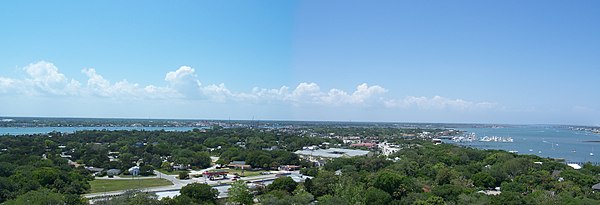
Civil rights movement

St. Augustine was a pivotal site for the Civil Rights Movement in 1963–1964.[16]
Efforts by African Americans to integrate the public schools and public accommodations such as lunch counters were met with arrests and Ku Klux Klan violence. Non-violent protesters were arrested for participating in peaceful picket lines, sit-ins, and marches. Homes were firebombed, black leaders were assaulted and threatened with death, and fired from their jobs.[17]
In the spring of 1964, St. Augustine civil rights leader Robert Hayling asked the Southern Christian Leadership Conference (SCLC) and its leader Martin Luther King, Jr. for assistance. From May until July 1964, they carried out marches, sit-ins, and other forms of peaceful protest in St. Augustine.
Hundreds of black and white civil rights supporters were arrested, and the jails were filled to overflowing. At the request of Hayling and King, white civil rights supporters from the north, including students, clergy, and well known public figures, came to St. Augustine and were arrested.
The KKK responded with violent attacks that were widely reported in national and international media. Popular revulsion against the Klan violence generated national sympathy for the black protesters and became a key factor in passage of the Civil Rights Act of 1964.[17]
In 2010, former United Nations Ambassador Andrew Young premiered his movie, "Crossing in St. Augustine" about the 1964 struggles against Jim Crow segregation. Young is now working to establish a National Civil Rights Museum in St. Augustine, which could be part of a St. Augustine National Historical Park and Seashore.[18]
Modern Era

The city is a popular tourist attraction, for its Spanish Colonial buildings as well as elite 19th century architecture. The city's historic center is anchored by St. George Street, which is lined with historic homes from various periods. Most of these homes are reconstructions of buildings that had been burned or demolished over the years, though a few of them are original.[19] [20]
The St. Augustine Alligator Farm, incorporated in 1908, is one of the oldest commercial tourist attractions in Florida, as is the Fountain of Youth, which dates from the same time period. The city is one terminus of the Old Spanish Trail, a promotional effort of the 1920s linking St. Augustine to San Diego, California, with 3,000 miles (4,800 km) of roadways.
The city has a privately funded Freedom Trail of historic sites of the civil rights movement, and a museum at the Fort Mose site, the location of the 1738 free black community. Historic Excelsior School, built in 1925 as the first public high school for blacks in St. Augustine, became the city's first museum of African-American history. In 2011, the St. Augustine Foot Soldiers Monument, a remembrance of participants in the civil rights movement, was dedicated in the downtown plaza, a few feet from the Slave Market. Robert Hayling, the leader of the St. Augustine movement, and Hank Thomas, who grew up in St. Augustine and was one of the original Freedom Riders, spoke at the dedication ceremony. Another corner of the plaza was designated "Andrew Young Crossing" in honor of the civil rights leader, who received his first beating in the movement in St. Augustine in 1964. Bronze replicas of Young's footsteps have been incorporated into the sidewalk that runs diagonally through the plaza, along with quotes expressing the importance of St. Augustine to the civil rights movement. That project was publicly funded. Some important landmarks of the civil rights movement, including the Monson Motel and the Ponce de Leon Motor Lodge, had been demolished in 2003 and 2004.
Geography and climate
St. Augustine is located at 29°53′39″N 81°18′48″W / 29.89417°N 81.31333°W (29.89785, -81.31151).Template:GR According to the United States Census Bureau, the city has a total area of 10.7 square miles (27.8 km²), of which, 8.4 square miles (21.7 km²) of it is land and 2.4 square miles (6.1 km²) of it (21.99%) is water. Access to the Atlantic Ocean is via the St. Augustine Inlet of the Matanzas River.
In modern times, St. Augustine has mostly been spared the wrath of tropical cyclones. The only direct hit was Hurricane Dora, which came ashore just after midnight on September 10, 1964. Hurricane Donna in 1960, and unnamed hurricanes in 1944 and 1950 also affected the area.
Demographics

As of the 2000 United States Census,Template:GR there were 9,592 people, 4,963 households, and 2,600 families residing in the city. The population density was 1,384.6 people per square mile (534.7/km²). There were 5,642 housing units at an average density of 673.9 per square mile (260.3/km²). The racial makeup of the city was 81.21% Caucasian, 15.07% African American, 0.41% Native American, 0.72% Asian, 0.09% Pacific Islander, 0.88% from other races, and 1.61% from two or more races. Hispanic or Latino of any race were 3.11% of the population.
There were 4,963 households out of which 18.6% had children under the age of 18 living with them, 37.4% were married couples living together, 12.4% had a female householder with no husband present, and 47.6% were non-families. 36.7% of all households were made up of individuals and 14.5% had someone living alone who was 65 years of age or older. The average household size was 2.11 and the average family size was 2.76.
In the city the population was spread out with 16.1% under the age of 18, 15.3% from 18 to 24, 23.9% from 25 to 44, 25.2% from 45 to 64, and 19.5% who were 65 years of age or older. The median age was 42 years. For every 100 females there were 84.6 males. For every 100 females age 18 and over, there were 81.4 males.
The median income for a household in the city was $32,358, and the median income for a family was $41,892. Males had a median income of $27,099 versus $25,121 for females. The per capita income for the city was $21,225. About 9.8% of families and 15.8% of the population were below the poverty line, including 25.8% of those under age 18 and 10.0% of those age 65 or over.
Transportation
Highways

 Interstate 95 runs north-south.
Interstate 95 runs north-south. U.S. Route 1 runs north-south.
U.S. Route 1 runs north-south. Florida State Road A1A runs north-south.
Florida State Road A1A runs north-south. Florida State Road 16 runs east-west
Florida State Road 16 runs east-west Florida State Road 207 runs northeast to southwest
Florida State Road 207 runs northeast to southwest Florida State Road 312 runs east-west
Florida State Road 312 runs east-west
Buses
Bus service is operated by the Sunshine Bus Company. Buses operate mainly between shopping centers across town, but a few go to Hastings and Jacksonville, where one can connect to JTA for additional service across Jacksonville.
Airport
St. Augustine has one public airport 5 miles (8.0 km) north of town. It has 5 runways (2 of them water for sea planes), and was once served by Skybus, however Skybus ceased operations as of April 4, 2008. Only private flights and tour helicopters use it today.
Points of interest

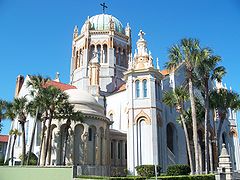

Spanish Eras
- Avero House
- Castillo de San Marcos National Monument
- Fort Matanzas National Monument
- Fort Mose Historic State Park
- Nombre de Dios
- Gonzalez-Alvarez House
- Fountain of Youth Archaeological Park
- The Spanish Military Hospital Museum
- St. Francis Barracks
- Spanish Quarter Village
- Ximenez-Fatio House
- Oldest Wooden Schoolhouse
- Tolomato Cemetery and Huguenot Cemetery
British Era
Pre-Flagler Era
Flagler Era
- Ponce de León Hotel
- Casa Monica Hotel
- Hotel Alcazar
- Zorayda Castle
- Bridge of Lions
- Old St. Johns County Jail
- Ripley's Believe it or Not! Museum located in 1887 mansion of William Worden.
- Alligator Farm
- J & S Carousel
Historic Churches
- Grace United Methodist Church
- Cathedral Basilica of St. Augustine
- Memorial Presbyterian Church
- Trinity Church of St. Augustine
Lincolnville National Historic District – Civil Rights Era
- Freedom Trail of Historic Sites of the Civil Rights Movement
- Excelsior School Museum of African American History
- St. Benedict the Moor School
Other
- Anastasia State Park
- Florida School for the Deaf and Blind
- St. Augustine Amphitheatre
- World Golf Hall of Fame
Sister cities
 Avilés, Spain
Avilés, Spain Cartagena, Colombia
Cartagena, Colombia Island of Menorca, Spain
Island of Menorca, Spain Santo Domingo, Dominican Republic
Santo Domingo, Dominican Republic
Education

Primary and secondary education in St. Augustine is overseen by the St. Johns County School District. There are no county high schools located within St. Augustine's current city limits, but St. Augustine High School, Pedro Menendez High School, and St. Johns Technical High School are located in the vicinity. The Florida School for the Deaf and Blind, a state-operated boarding school for deaf and blind students, was founded in the city in 1885.[21] The Catholic Diocese of St. Augustine operates the St. Joseph Academy, Florida's oldest Catholic high school, to the west of the city.[22]
There are several institutions of higher education in and around St. Augustine. Flagler College is a four-year liberal arts college founded in 1968. It is located in the former Ponce de León Hotel in downtown St. Augustine.[23] St. Johns River State College, a state college in the Florida College System, has its St. Augustine campus just west of the city. Also in the area are the University of North Florida, Jacksonville University, and Florida State College at Jacksonville in Jacksonville.[24]
The institution now known as Florida Memorial University was located in St. Augustine from 1918 to 1968, when it relocated to its present campus in Miami. Originally known as Florida Baptist Academy, then Florida Normal, and then Florida Memorial College, it was a historically black institution and had a wide impact on St. Augustine while it was located there. During World War II it was chosen as the site for training the first blacks in the U. S. Signal Corps. Among its faculty members was Zora Neale Hurston; a historic marker is placed at the house where she lived while teaching at Florida Memorial (and where she wrote her autobiography Dust Tracks on a Road.)[citation needed]
Notable residents


- Jim Albrecht, poker tournament director and commentator
- Andrew Anderson, doctor, former St. Augustine mayor
- Murray Armstrong, hockey coach
- Jorge Biassou, Haitian revolutionary, and America's first black general
- Richard Boone, actor
- James Branch Cabell, novelist
- Doug Carn, jazz musician
- Cris Carpenter, baseball player
- Ray Charles, pianist
- Earl Cunningham, artist
- Alexander Darnes, born a slave, became a celebrated physician
- Edmund Jackson Davis, governor
- Frederick Delius, composer
- Stephen Farrelly, pro wrestler
- Henry Flagler, industrialist
- Tom Gabel, singer
- Willie Galimore, football player
- Michael Gannon, historian
- William H. Gray, U. S. congressman and president of the United Negro College Fund
- Martin Johnson Heade, artist
- Louise Homer, opera star
- Sidney Homer, composer
- Jack D. Hunter, novelist, author of The Blue Max
- Zora Neale Hurston, novelist and folklorist
- Lindy Infante, professional (American) football coach
- Willie Irvin, pro (American) football player
- Stetson Kennedy, author
- Jack Temple Kirby, historian
- Scott Lagasse Jr., race car driver
- Jacob Lawrence, artist
- John C. Lilly, dolphin scientist
- William W. Loring, Confederate general
- Mary MacLane, author
- Albert Manucy, historian, author, Fulbright Scholar
- George McGovern, U.S. Senator, presidential candidate
- Howell W. Melton, United States district judge
- Howell W. Melton Jr., attorney, law firm managing partner
- Johnny Mize, Hall of Fame baseball player
- Prince Achille Murat, nephew of Napoleon Bonaparte
- David Nolan, author and historian
- Osceola, Seminole War leader (held prisoner at Fort Marion, now Castillo de San Marcos)
- Tom Petty, rock musician
- Scott Player, pro (American) football punter
- Richard Henry Pratt, soldier and educator
- Marjorie Kinnan Rawlings, novelist
- Marcus Roberts, musician
- Gamble Rogers, folksinger
- John M. Schofield, Union general
- Steven L. Sears, television writer/producer
- Edmund Kirby Smith, Confederate general
- Steve Spurrier, college/pro (American) football coach
- Peter Taylor, novelist
- Travis Tomko, pro wrestler
- Felix Varela, Cuban national hero
- Augustin Verot, first Bishop of St. Augustine
- David Levy Yulee, first Jewish U.S. Senator, Levy County and Yulee, Florida namesake
- DeWitt Webb, physician, former St. Augustine mayor, State representative
- Sheamus, Irish Wrestling superstar
Gallery
-
St. Augustine waterfront with Castillo de San Marcos in distance (1860s).
-
Government House as seen from the Town Plaza c. 1861–1865
-
Historic Huguenot Cemetery
-
Tovar House, 22 St. Francis St.
-
Castillo de San Marcos, Civil War era.
-
Panorama of Castillo de San Marcos, Flagler College and downtown St. Augustine from lighthouse, June, 2011
-
Replicas of the Medici lions at the Bridge of Lions post restoration 2011
References
- ^ a b National Historic Landmarks Program – St. Augustine Town Plan Historic District
- ^ Lawson, pp. 29–32
- ^ George M. Brown, Ponce de Leon Land and Florida War Record, p. 99.
- ^ a b "Menendez Fort and Camp". Historical Archaeology. Florida Museum of Natural History. p. 1. Retrieved May 29, 2011.
- ^ "Menendez Fort and Camp". Historical Archaeology. Florida Museum of Natural History. p. 2. Retrieved May 29, 2011.
- ^ "Experience Your America" U.S. National Park Service.
- ^ Reps, John W. (1992), The making of urban America: a history of city planning in the United States, Princeton University Press, p. 33, ISBN 978-0-691-00618-5
- ^ Manucy, Albert C. (1992), Menéndez: Pedro Menéndez de Avilés, Captain General of the Ocean Sea, Pineapple Press, p. 33, ISBN 978-1-56164-015-7
- ^ http://www.flmnh.ufl.edu/histarch/foy_site_reports.htm
- ^ Seraphin, Judith (April 17, 2011), "The Accidental Abolitionist", (reader letter) New York Times Magazine
- ^ Hann, John H. (1996) A History of the Timucua Indians and Missions, pp. 55–57. University Press of Florida. ISBN 0-8130-1424-7.
- ^ Henry Flagler, Builder of Florida By Sandra Wallus Sammons p. 16
- ^ The Conductor and brakeman, Volume 18 By Order of Railway Conductors and Brakemen p.17
- ^ Wilson, Gil: "Alicia Hospital" Dr. Bronson's History of St. Augustine
- ^ Adams, William R.: St. Augustine and St. Johns County: A Historical Guide ISBN 1-56164-432-3, page 60
- ^ "St. Augustine Movement 1963–1964". Civil Rights Movement Veterans. 2004. Retrieved March 4, 2011.
- ^ a b Branch, Taylor (1998). Pillar of Fire. Simon & Schuster.
- ^ url = http://www.staugustgreen.com
- ^ "Maps and Directions for St. Augustine Florida". The St. Augustine Record. Retrieved November 10, 2011.
- ^ "St. George Street" (PDF). The St. Augustine Record. Retrieved November 10, 2011.
- ^ Florida School for the Deaf and the Blind website
- ^ "School is Tradition". The Florida Times-Union/Shorelines. February 13, 2003. Retrieved May 18, 2011.
- ^ Reiss, Sarah W. (2009). Insiders' Guide to Jacksonville, 3rd Edition. Globe Pequot. p. 184. ISBN 0-7627-5032-4. Retrieved May 10, 2011.
{{cite book}}: Cite has empty unknown parameter:|coauthors=(help) - ^ Reiss, Sarah W. (2009). Insiders' Guide to Jacksonville, 3rd Edition. Globe Pequot. ISBN 0-7627-5032-4. Retrieved May 18, 2011.
{{cite book}}: Cite has empty unknown parameter:|coauthors=(help)
Additional reading
- Abbad y Lasierra, Iñigo, "Relación del descubrimiento, conquista y población de las provincias y costas de la Florida" – "Relación de La Florida" (1785); edición de Juan José Nieto Callén y José María Sánchez Molledo.
- Colburn, David, Racial Change and Community Crisis: St. Augustine, Florida, 1877–1980 (1985), New York: Columbia University Press.
- Deagan, Kathleen, Fort Mose: Colonial America's Black Fortress of Freedom (1995), Gainesville: University Press of Florida.
- Fairbanks, George R. (George Rainsford), History and antiquities of St. Augustine, Florida (1881), Jacksonville, Florida, H. Drew.
- Gannon, Michael V., The Cross in the Sand: The Early Catholic Church in Florida 1513–1870 (1965), Gainesville: University Presses of Florida.
- Graham, Thomas, The Awakening of St. Augustine, (1978), St. Augustine Historical Society
- Hanna, A. J., A Prince in Their Midst, (1946), Norman: University of Oklahoma Press.
- Harvey, Karen, America's First City, (1992), Lake Buena Vista, Florida: Tailored Tours Publications.
- Harvey, Karen, St. Augustine Enters the Twenty-first Century, (2010), Virginia Beach, VA: The Donning Company.
- Landers, Jane, Black Society in Spanish Florida (1999), Urbana and Chicago: University of Illinois Press.
- Lardner, Ring, Gullible's Travels, (1925), New York: Scribner's.
- Lyon, Eugene, The Enterprise of Florida, (1976), Gainesville: University Press of Florida.
- Manucy, Albert, Menendez, (1983), St. Augustine Historical Society.
- McCarthy, Kevin (editor), The Book Lover's Guide to Florida, (1992), Sarasota, Florida: Pineapple Press.
- Nolan, David, Fifty Feet in Paradise: The Booming of Florida, (1984), New York: Harcourt Brace Jovanovich.
- Nolan, David, The Houses of St. Augustine, (1995), Sarasota, Florida: Pineapple Press.
- Porter, Kenneth W., The Black Seminoles: History of a Freedom-Seeking People, (1996), Gainesville: University Press of Florida.
- Reynolds, Charles B. (Charles Bingham), Old Saint Augustine, a story of three centuries, (1893), St. Augustine, Florida E. H. Reynolds.
- Torchia, Robert W., Lost Colony: The Artists of St. Augustine, 1930-1950, (2001), St. Augustine: The Lightner Museum.
- Turner, Glennette Tilley, Fort Mose, (2010), New York: Abrams Books.
- United States Commission on Civil Rights, 1965. Law Enforcement: A Report on Equal Protection in the South. Washington, D.C.: Government Printing Office.
- Warren, Dan R., If It Takes All Summer: Martin Luther King, the KKK, and States' Rights in St. Augustine, 1964, (2008), Tuscaloosa: University of Alabama Press.
- Waterbury, Jean Parker (editor), The Oldest City, (1983), St. Augustine Historical Society.
Images
- Freedom Trail information about the civil rights movement in St. Augustine and the Freedom Trail that marks its sites.
- St. Augustine Pics Daily pictures of St. Augustine, Florida.
- Twine Collection Over 100 images of the St. Augustine community of Lincolnville between 1922 and 1927. From the State Library & Archives of Florida.
External links
Government resources
Local news media
- The St. Augustine Record/staugustine.com, owned by Morris Communications, is St. Augustine's only daily newspaper.
- Historic City News, daily online news journal
- St Augustine Community News, Open Residents participation type news portal
Historical
- Castillo de San Marcos official website, U.S. National Park Service
- St. Augustine Lighthouse and Museum
- Lighthouse Archaeological Maritime Program (LAMP), maritime archaeology in St. Augustine
- History page (augustine.com)
- "St. Augustine Movement" in online King Encyclopedia (Stanford University)
- "St. Augustine Movement 1963–1964" at Civil Rights Movement Veterans website
Higher education

